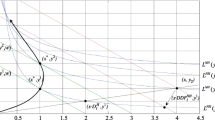Abstract
The directional technology distance function is introduced, given an interpretation as a min-max, and compared with other functional representations of the technology including the Shephard input and output distance functions and the McFadden gauge function. A dual correspondence is developed between the directional technology distance function and the profit function, and it is shown that all previous dual correspondences are special cases of this correspondence. We then show how Nerlovian (profit-based) efficiency measures can be computed using the directional technology distance function.
Similar content being viewed by others
References
Nerlove, M., Estimation and Identification of Cobb-Douglas Production Functions, Rand McNally Company, Chicago, Illinois, 1965.
Farrell, M. J., The Measurement of Productive Efficiency, Journal of the Royal Statistical Society, Vol. 129A, pp. 253-281, 1957.
Lau, L. J., and Yotopoulos, P. A., Test for Relative Efficiency and an Application to Indian Agriculture, American Economic Review, Vol. 61, pp. 94-109, 1971.
Luenberger, D. G., New Optimality Principles for Economic Efficiency and Equilibrium, Journal of Optimization Theory and Applications, Vol. 75, pp. 221-264, 1992.
Luenberger, D., Microeconomic Theory, McGraw Hill, New York, New York, 1995.
Blackorby, C., and Donaldson, D., A Theoretical Treatment of Indices of Absolute Inequality, International Economic Review, Vol. 21, pp. 107-136, 1980.
McFadden, D., Cost, Revenue, and Profit Functions, Production Economics: A Dual Approach to Theory and Applications, Edited by M. Fuss and D. McFadden, North Holland, Amsterdam, Holland, Vol. 1, pp. 1-110, 1978.
Chambers, R. G., Chung, Y., and FÄre, R., Benefit and Distance Functions, Journal of Economic Theory, Vol. 70, pp. 407-419, 1996.
Shephard, R. W., Cost and Production Functions, Princeton University Press, Princeton, New Jersey, 1953.
Shephard, R. W., Theory of Cost and Production Functions, Princeton University Press, Princeton, New Jersey, 1970.
Luenberger, D. G., Benefit Functions and Duality, Journal of Mathematical Economics, Vol. 21, pp. 461-481, 1992.
Luenberger, D. G., Dual Pareto Efficiency, Journal of Economic Theory, Vol. 62, pp. 70-84, 1994.
Luenberger, D. G., Optimality and the Theory of Value, Journal of Economic Theory, Vol. 63, pp. 147-169, 1994.
FÄre, R., Fundamentals of Production Theory, Springer Verlag, Berlin, Germany, 1988.
FÄre, R., and Primont, D., Multi-Output Production and Duality: Theory and Applications, Kluwer Academic Publishers, Boston, Massachusetts, 1995.
Chung, Y., Directional Distance Functions and Undesirable Outputs, PhD Thesis, Southern Illinois University, 1996.
Debreu, G., The Coefficient of Resource Utilization, Econometrica, Vol. 19, pp. 273-292, 1951.
Briec, W., A Graph Type Extension of Farrell Technical Efficiency Measure, Journal of Productivity Analysis, Vol. 8, pp. 95-110, 1997.
Author information
Authors and Affiliations
Rights and permissions
About this article
Cite this article
Chambers, R.G., Chung, Y. & Färe, R. Profit, Directional Distance Functions, and Nerlovian Efficiency. Journal of Optimization Theory and Applications 98, 351–364 (1998). https://doi.org/10.1023/A:1022637501082
Issue Date:
DOI: https://doi.org/10.1023/A:1022637501082




